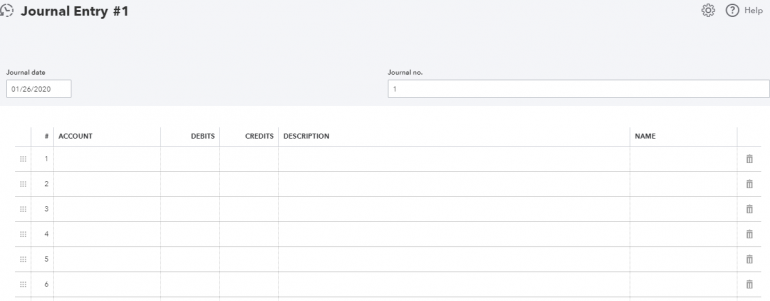What Are Accounting Adjustments?
Understand adjusting entries for accounting purposes, how they are made and what they impact.

Many, or all, of the products featured on this page are from our advertising partners who compensate us when you take certain actions on our website or click to take an action on their website. However, this does not influence our evaluations. Our opinions are our own. Here is a list of our partners and here's how we make money.
Adjusting entries are made at the end of the accounting period to make your financial statements more accurately reflect your income and expenses, usually — but not always — on an accrual basis. This can be at the end of the month or the end of the year.
If you have adjusting entries that need to be made to your financial statements before closing your books for the year, does that mean your books aren't as accurate as you thought? This article will take a close look at adjusting entries for accounting purposes, how they are made, what they affect and how to minimize their impact on your financial statements.
advertisement
Adjusting entries defined
In order to maintain accurate business financials, you or your bookkeeper will enter income and expenses as they are recognized in your business. This can be done on either a cash basis or an accrual basis.
Regardless of how meticulous your bookkeeping is, though, you or your accountant will have to make adjusting entries from time to time. An adjusting entry is simply an adjustment to your books to better align your financial statements with your income and expenses.
Adjusting entries are made at the end of the accounting period. This can be at the end of the month or the end of the year. Your accountant will likely give you adjusting entries to be made on an annual basis, but your bookkeeper might make adjustments monthly.
How adjusting entries are made
Adjusting entries are typically made using a journal entry. If you use small-business accounting software — like QuickBooks, Xero or FreshBooks — you might not be familiar with journal entries. That’s because most accounting software posts the journal entries for you based on the transactions entered.
Double-entry accounting stipulates that every transaction in your bookkeeping consists of a debit and a credit, which must be kept in balance for your books to be accurate. Your accounting software takes care of this for you. For example, when you enter a check in your accounting software, you likely complete a form on your computer screen that looks similar to a check. Behind the scenes, though, your software is debiting the expense account (or category) you use on the check and crediting your checking account.
When you make a journal entry, the automated component is stripped away, and you are left with something that looks like this:

Types of accounting adjustments
Adjusting entries usually involve one or more balance sheet accounts and one or more accounts from your profit and loss statement. In other words, when you make an adjusting entry to your books, you are adjusting your income or expenses and either what your company owns (assets) or what it owes (liabilities).
Adjusting entries usually fall into one of four categories:
Accruals
Most accruals will be posted automatically in the course of your accrual basis accounting. However, there are times — like when you have made a sale but haven’t billed for it yet at the end of the accounting period — when you would need to make an accrual entry.
Another common accrual happens at year-end. Let’s say you pay your employees on the 1st and 15th of each month. At year-end, half of December’s wages have not yet been paid; they will be paid on the 1st of January. If you keep your books on a true accrual basis, you would need to make an adjusting entry for these wages dated Dec. 31 and then reverse it on Jan. 1.
Accrual entry example
Using the above payroll example, let’s say as of Dec. 31 your employees had earned wages totaling $8,750 for the period from Dec. 15 through Dec. 31. They didn’t receive these wages until Jan. 1, because you pay your employees on the 1st and 15th of each month.
Even though the money had not yet left your account at year-end, you still incurred that expense. In true accrual basis accounting, you would need to make an adjusting entry to your books to match that expense to the period in which it was incurred. And you would do so with the following entry:

This entry would increase your Wages and Salaries expense on your profit and loss statement by $8,750, which in turn would reduce your net income for the year by $8,750.
The Wages and Salaries Payable account is a liability account on your balance sheet. When you actually pay your employees, the checking account for the business — also on the balance sheet — is impacted. But when you record accrued expenses, a liability account is created and impacted with your adjusting entry.
Whenever you make an entry like this, it’s important to record a reversing entry in the following accounting period. So, on Jan. 1, you would make the following entry:

Now, when you record your payroll for Jan. 1, your Wages and Salaries expense won’t be overstated.
Again, this type of adjustment is not common in small-business accounting, but it can give you a lot of clarity about your true costs per accounting period.
Deferrals
In practice, you are more likely to encounter deferrals than accruals in your small business. The most common deferrals are prepaid expenses and unearned revenues.
Let’s say you pay your business insurance for the next 12 months in December of each year. You have paid for this service, but you haven’t used the coverage yet. This would be recorded as a prepaid expense in your books.
Or perhaps a customer has made a deposit for services you have not yet rendered. You are holding their money, but you haven’t earned it yet. This would be posted as unearned revenue in your books.
Deferral entry example
Using the business insurance example, you paid $1,200 for next year’s coverage on Dec. 17 of the previous year. If you are a cash basis taxpayer, this payment would reduce your taxable income for the previous year by $1,200.
However, for management purposes, you haven’t actually used what you have paid for as of Dec. 31. The adjusting entry dated Dec. 31 would be:

Let’s pause here for a moment for an explanation of what happened “behind the scenes” when you made your insurance payment on Dec. 17. When you entered the check into your accounting software, you debited Insurance Expense and credited your checking account. However, that debit — or increase to — your Insurance Expense account overstated the actual amount of your insurance premium on an accrual basis by $1,200. So, we make the adjusting entry to reduce your insurance expense by $1,200. And we offset that by creating an increase to an asset account — Prepaid Expenses — for the same amount.
Each month of the following year, you would make the following entry to your books:

This entry will recognize the insurance expense as you actually incur it, at the rate of $100 per month ($100 x 12 months = the $1,200 you paid for your insurance premiums for the year). At the same time, your Prepaid Expenses asset account will be reduced by $100 per month.
At the end of the following year, then, your Insurance Expense account on your profit and loss statement will show $1,200, and your Prepaid Expenses account on your balance sheet will be at $0.
This type of entry is more common in small-business accounting than accruals. However, if you make this entry, you need to let your tax preparer know about it so they can include the $1,200 you paid in December on your tax return. Remember, we are making these adjustments for management purposes, not for taxes.
Depreciation and amortization
For tax purposes, your tax preparer might fully expense the purchase of a fixed asset when you purchase it. However, for management purposes, you don’t fully use the asset at the time of purchase. Instead, it is used up over time, and this use is recorded as a depreciation expense. Whereas you’d record a depreciation entry for a tangible asset, amortization is used to stretch the expense of intangible assets over a period of time.
Depreciation and amortization are common accounting adjustments for small businesses.
Depreciation and amortization entry example
This is probably an entry you are familiar with, but chances are you are only familiar with it as it impacts your taxes.
Whenever you purchase a fixed asset — like a vehicle, building or large equipment — for your business, you don’t post the purchase directly to an expense account. Instead, the purchase is recorded to an asset account. The “behind-the-scenes” entry for the purchase of a $35,000 truck, for example, would be:

(If you didn’t pay for the vehicle in full, the credit would be posted to a long-term liability account. For simplicity’s sake, we’ll assume you paid cash.)
The Vehicles account is a fixed asset account on your balance sheet. We post the purchase in this manner because you don’t fully deplete the usefulness of the truck when you purchase it. You’ll probably keep the truck for several years.
Let’s say you will keep the truck for five years, and then you will replace it. When you are done with the truck, you will sell it for $10,000 — the salvage value of the truck. The straight-line depreciation rate for the truck will be calculated as follows:
(Acquisition Cost – Salvage Value) / Useful Life = Depreciation Rate
($35,000 – $10,000) / 5 = Depreciation Rate
$25,000 / 5 = $5,000
You will depreciate the truck at a rate of $5,000 per year, or approximately $416.67 per month.
The adjusting entry to your books each month, then, would be:

The depreciation expense shows up on your profit and loss statement each month, showing how much of the truck’s value has been used that month. Accumulated depreciation is a contra asset account. This means it shows up under your Vehicle asset account on your balance sheet as a negative number. This has the net effect of reducing the value of your assets on your balance sheet while still reflecting the purchase value of the vehicle.
Unlike accruals, there is no reversing entry for depreciation and amortization expense.
Keep in mind, this calculation and entry will not match what your accountant calculates for depreciation for tax purposes. But this entry will let you see your true expenses for management purposes.
Estimates
Some businesses set up reserve accounts for expenses they think their company might incur, but they don’t have an actual amount yet. Two common estimate entries are for bad debt allowance: the portion of accounts receivable that the business estimates might be uncollectible based on its A/R collection history; and inventory spoilage/loss, or the amount of inventory the business estimates it will lose due to spoilage, obsolescence, theft or some other non-revenue activity.
Estimate entry example
Let’s assume you have $250,000 in inventory and you know you typically lose 2% of your inventory to theft or spoilage each year.
First, let’s calculate the dollar amount of the inventory loss:
$250,000 x 0.02 = $5,000
You lose, on average, $5,000 of your inventory each year. On a monthly basis, that’s $416.67. So, each month, you would make the following entry to your books:

The Inventory Loss account could either be a sub-account of cost of goods sold, or you could list it as an operating expense. We prefer to see it as an operating expense so it doesn’t skew your gross profit margin. The Reserve for Inventory Loss account is a contra asset account, and it shows up under your Inventory asset account on your balance sheet as a negative number.
When you do your physical inventory each year, you will reverse the entry for the year:

And then you will record the actual inventory loss. Let’s say it winds up being $3,750.

Because you know your inventory amount has decreased by $3,750, you will adjust your actual inventory number instead of posting to the reserve account.
Like accruals, estimates aren’t common in small-business accounting.
When to make adjustments in accounting
Adjusting entries are typically made after the trial balance has been prepared and reviewed by your accountant or bookkeeper. Sometimes, your bookkeeper can enter a recurring transaction, and these entries will be posted automatically each month before the close of the period.
Other times, the adjustments might have to be calculated for each period, and then your accountant will give you adjusting entries to make after the end of the accounting period. Either way, make sure you understand the purpose of the entry.
Having adjusting entries doesn’t necessarily mean there is something wrong with your bookkeeping practices. If you are concerned something might be amiss, speak with your accountant; they will be able to tell you if something needs to be changed in your bookkeeping processes to reduce the need for adjusting entries.
Bookkeeping and accounting software | ||
|---|---|---|
| | QuickBooks Online $30 per month and up. Read Review. | |
| | FreshBooks Accounting $19 per month and up. Read Review. | |
| | Xero $15 per month and up. | |
| | Zoho Books $0 per month and up. | |
| | Sage 50 Accounting $48.17 per month (when paid annually) and up. | |
| | Wave Financial Free (add-ons available). | |
A version of this article was first published on Fundera, a subsidiary of NerdWallet.
Article sources
NerdWallet writers are subject matter authorities who use primary,
trustworthy sources to inform their work, including peer-reviewed
studies, government websites, academic research and interviews with
industry experts. All content is fact-checked for accuracy, timeliness
and relevance. You can learn more about NerdWallet's high
standards for journalism by reading our
editorial guidelines.
Bonus offer
Best Accounting Software for Small Businesses
More like this
Related articles











